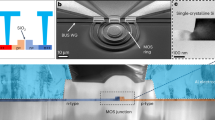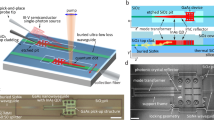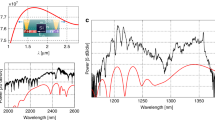Abstract
Waveguide-integrated photonic modulators are crucial devices when encoding optical signals for electronic–photonic integration on silicon1,2. Silicon photonic modulators based on the free carrier plasma dispersion effect3 have undergone significant development in recent years4,5,6,7,8,9,10, reaching speeds of 40 Gbit s–1 (ref. 7). Some issues yet to be resolved include the large size and the relatively high energy consumption of silicon Mach–Zehnder interferometer modulators, and the susceptibility to fabrication errors as well as a limited operation wavelength range of ∼1 nm for silicon microring modulators. We demonstrate the first waveguide-integrated GeSi electro-absorption modulator on silicon with a small active device area of 30 µm2, a 10-dB extinction ratio at 1,540 nm, an operating spectrum range of 1,539–1,553 nm, ultralow energy consumption of 50 fJ per bit, and a 3-dB bandwidth of 1.2 GHz. This device offers unique advantages for use in high-performance electronic–photonic integration with complementary metal oxide semiconductor circuits.
This is a preview of subscription content, access via your institution
Access options
Subscribe to this journal
Receive 12 print issues and online access
$209.00 per year
only $17.42 per issue
Buy this article
- Purchase on Springer Link
- Instant access to full article PDF
Prices may be subject to local taxes which are calculated during checkout



Similar content being viewed by others
References
Soref, R. A. The past, present and future of silicon photonics. IEEE. J. Sel. Top. Quant. Electron. 12, 1678–1687 (2006).
Kimerling, L. C. et al. Electronic–photonic integrated circuits on the CMOS platform. Proc. SPIE 6125, 612502 (2006).
Soref, R. A. & Bennett, B. R. Electro-optical effects in silicon. IEEE J. Quant. Electron. 23, 123–129 (1987).
Liu, A. et al. A high-speed silicon optical modulator based on a metal-oxide-semiconductor capacitor. Nature 427, 615–618 (2004).
Xu, Q., Schmidt B., Pradhan, S. & Lipson M. Micrometre-scale silicon electro-optic modulator. Nature 435, 325–327 (2005).
Liu, A. et al. High-speed optical modulation based on carrier depletion in a silicon waveguide. Opt. Express 15, 660–668 (2007).
Liao, L. et al. 40 Gbit/s silicon optical modulator for high speed applications. Electron. Lett. 43, 1196–1197 (2007).
Green, W. M. J., Rooks, M. J., Sekaric, L. & Vlasov, Y. A. Ultra-compact, low RF power, 10 Gb/s silicon Mach–Zehnder modulator. Opt. Express 15, 17106–17113 (2007).
Xu, Q., Manipatruni, S., Schmidt, B., Shakya, J. & Lipson, M. 12.5 Gbit/s carrier-injection-based silicon microring silicon modulators. Opt. Express 15, 430–436 (2007).
Manipatruni, S., Xu, Q. & Lipson, M. PINIP based high-speed high-extinction ratio micron-size silicon electro-optic modulator. Opt. Express 15, 13035–13042 (2007).
Lampin, J. F., Desplanque, L. & Mollot, F. Detection of picosecond electrical pulses using the intrinsic Franz–Keldysh effect. Appl. Phys. Lett. 78, 4103–4105 (2001).
Jongthanmmanurak, S. et al. Large electro-optic effect in tensile strained Ge-on-Si films. Appl. Phys. Lett. 89, 161115 (2006).
Kuo, Y. H. et al. Strong quantum-confined Stark effect in germanium quantum-well structures on silicon. Nature 437, 1334–1336 (2005).
Kuo, Y. H. et al. Quantum-confined stark effect in Ge/SiGe quantum wells on Si for optical modulators. IEEE J. Sel. Top. Quant. Electron. 12, 1503–1513 (2006).
Roth, J. E. et al. Optical modulator on silicon employing germanium quantum wells. Opt. Express 15, 5851–5859 (2007).
Liu, J. F. et al. Design of monolithically integrated GeSi electro-absorption modulators and photodetectors on an SOI platform. Opt. Express 15, 623–628 (2007).
Liu, J. F. et al. Waveguide-integrated Ge p-i-n photodetectors on Si. 3rd IEEE International Conference on Group IV Photonics (IEEE cat. no. 06EX1276C), Ottawa, ON, Canada, 13–15 September 2006, 173–175.
Beals, M. et al. Process flow innovations for photonic device integration in CMOS. Proc. SPIE 6898, 689804 (2008).
Frova, A. & Handler, P. Franz–Keldysh effect in the space-charge region of a germanium p-n junction. Phys. Rev. 137, A1857–A1861 (1965).
Dash, W. C. & Newman, R. Intrinsic optical absorption in single-crystal germanium and silicon at 77 K and 300 K. Phys. Rev. 99, 1151–1155 (1955).
Madelung, O. (ed.) Physics of group IV elements and III–V compounds, in Numerical Data and Functional Relationships in Science and Technology vol. 17a, 88 (Springer, Berlin, 1982).
Chin, M. K. & Chang, W. S. C. Theoretical design optimization of multiple-quantum-well electroabsorption waveguide modulators. IEEE J. Quant. Electron. 29, 2476–2488 (1993).
Chou, H. F. & Bowers, J. E. High-speed OTDM and WDM networks using traveling-wave electroabsorption modulators. IEEE. J. Sel. Top. Quant. Electron. 13, 58–69 (2007).
Liu, B. et al. Analog characterization of low-voltage MQW traveling-wave electroabsorption modulators. J. Lightwave Technol. 21, 3011–3019 (2003).
Loi, K. K., Hodiak, J. H., Mei, X. B., Tu, C. W. & Chang, W. S. C. Linearization of 1.3-µm MQW electroabsorption modulators using an all-optical frequency-insensitive technique. IEEE Photon. Technol. Lett. 10, 964–966 (1998).
Chou, H. F. & Bowers, J. E. Simplified optoelectronic 3R regenerator using nonlinear electro-optical transformation in an electroabsorption modulator. Opt. Express 13, 2742–2746 (2005).
Acknowledgements
This research was sponsored under the Defense Advanced Research Projects Agency's (DARPA) EPIC program supervised by J. Shah in the Microsystems Technology Office (MTO) under contract no. HR0011-05-C-0027. The authors would like to thank K. Wada and D. Pan for their early contributions to this work, and D. Gill from Alcatel-Lucent Bell Laboratories and S. Akiyama from Fujitsu Laboratories for helpful discussions.
Author information
Authors and Affiliations
Corresponding author
Rights and permissions
About this article
Cite this article
Liu, J., Beals, M., Pomerene, A. et al. Waveguide-integrated, ultralow-energy GeSi electro-absorption modulators. Nature Photon 2, 433–437 (2008). https://doi.org/10.1038/nphoton.2008.99
Received:
Accepted:
Published:
Issue Date:
DOI: https://doi.org/10.1038/nphoton.2008.99
This article is cited by
-
Reduced Threading Dislocation Density in a Ge Epitaxial Film on a Submicron-Patterned Si Substrate Grown by Chemical Vapor Deposition
Journal of Electronic Materials (2023)
-
High-performance Mach–Zehnder modulator using tailored plasma dispersion effects in an ITO/graphene-based waveguide
Scientific Reports (2022)
-
Electro-absorption modulation in GeSn alloys for wide-spectrum mid-infrared applications
Communications Materials (2021)
-
Lithium niobate photonic-crystal electro-optic modulator
Nature Communications (2020)
-
The Effect of Carrier Distribution on Performance of ENZ-Based Electro-Absorption Modulator
Plasmonics (2020)



